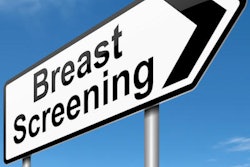
A new model-based analysis of mammography in the U.K. published Thursday in the British Medical Journal has found that the harms of breast screening may outweigh the benefits for up to 10 years after a screening program starts.
Specifically, breast cancer screening boosts the number of false positives, leads to unnecessary surgery, and reduces quality-adjusted life years (QALYs), according to the authors. Adding in such factors could lead to a different cost/benefit calculation than the one that was originally used to justify mammography screening in the U.K. some 25 years ago.
Indeed, the U.K.'s National Health Service is currently engaged in a review of the harms and benefits of its breast screening program, according to an announcement made in October. The new study may also help fuel recent criticism of the effectiveness of mammography screening.
Harms and benefits
According to the new analysis, the harms of screening offset the benefits for up to 10 years after screening starts. After that, benefits accumulate, but by much less than predicted when screening was first started, said James Raftery, PhD, a professor of health technology assessment at Wessex Institute and member of the faculty of medicine at the University of Southampton in the U.K (BMJ, 8 December 2011, online first).
"Our analysis shows that inclusion of the harms from false-positive results and unnecessary surgery reduced the benefits of screening by about half with negative net QALYs in the early years after the introduction of screening," wrote Raftery and his colleague Maria Chorozoglou, a research fellow.
The study is an update of the Forrest Report, which came out in 1986 and led to the introduction of breast cancer screening in the U.K. The report estimated the number of screened and unscreened women surviving each year over a 15-year period. Cost and benefits were measured in quality-adjusted life years, but the report omitted any mention of the potential harms of screening.
Raftery and Chorozoglou based the results of their updated version on 100,000 women age 50 and older who survived by one year up to 20 years after inclusion in the screening program. Inclusion of false positives and unnecessary surgery reduced the updated estimate of net cumulative QALYs gained after 20 years from 3,301 to 1,536, or by more than half.
For point of comparison, the best estimates from a 2009 review by the Nordic Cochrane Centre in Copenhagen (Peter Gøtzsche et al) generated negative QALYs for the first seven years of screening, 70 QALYs after 10 years, and 834 QALYs after 20 years.
"Assessment of the effects of mammographic breast screening in terms of mortality or life years inevitably shows positive benefits because of the omission of harms," the researchers wrote. "Despite its espousal of a QALY framework, the Forrest Report focused mainly on life years gained, which it adjusted for quality of life only from necessary surgery and ignored all other harms."
There are limitations to the new study, the researchers wrote. It relies heavily on clinical trials, most of which were completed in other countries several decades ago.
"As mortality from breast cancer in 1985 was higher in England than in those trials, we took as baseline the rate for England for 1985, before screening was introduced," they wrote. "We have assumed that the risk reductions shown in the trials apply to this higher baseline rate. An assessment of the value added by screening today might require disentangling the effects of screening from the effects of improved treatments, which is difficult."
It would also require recognizing how breast cancer screening methods have changed, they added.
"More research is required on the extent of unnecessary treatment and its impact on quality of life," the researchers wrote. "Most of the observational studies of overtreatment have focused on the relation between the incidence of breast cancer and mortality rather than on the levels of treatment, especially surgery."
Research priorities should be on improving ways of identifying those most likely to benefit from surgery and for measuring the levels and duration of the harms from surgery, they noted.
"As randomized trials might be the only way to resolve the extent of overtreatment, researchers in countries that have not yet implemented breast cancer screening should consider trials that include the harms of screening," the researchers wrote. "There have been suggestions for more sophisticated approaches to the prevention and treatment of breast cancer. From a public perspective, the meaning and implications of overdiagnosis and overtreatment need to be much better explained and communicated to any woman considering screening."



















